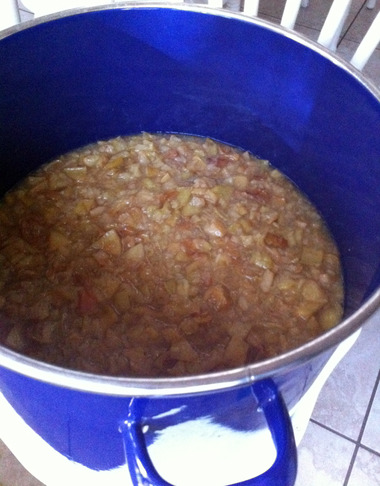Homemade Apple Scrap Vinegar
Update April 2013: Please check out my more recent post about scrap vinegar here with photos of the stages you’ll encounter and more tips based on my experience making successive batches of vinegars.
I’ll go ahead and just put it out there first thing. This is a project wherein everyone who lives under your roof needs to be enthusiastic, unless you have some sort of out-of-the-way cellar or garage that stays at or around 80 degrees F. You’re making vinegar. It’s going to smell like vinegar after about a week. Be warned.
There’s no specific recipe for this as you can make as small or large a batch as you have scraps.
My first batch of cider vinegar came from scraps that started out as apples simmered in water and then pureed through a food mill. I took a chance on the mealy skins and chunks, hoping that cooked vs raw would provide sufficient apple-ness in my soon-to-be vinegar.
It worked for me, and I’m now working on another batch of cider vinegar, but this time with raw scraps. I’ll post an update after a month to let you know how it goes.
This method is based on Sandor Ellix Katz’s fruit scrap vinegar recipe from his fablulous book, Wild Fermentation.
Homemade Apple Cider Vinegar Recipe
1. Save those cores and peels from pies and apple preserving projects. Use organic apple scraps, or know your local apple grower’s spraying policies. For your first batch I’d recommend using between 5-10 apples’ worth of scraps. Use your cooked, apple butter scraps if that’s what you have. Freeze your scraps from smaller projects if you’d like and just use frozen scraps as you would with fresh (don’t worry about defrosting).
Place your scraps in your widest-base, food-safe container. Avoid aluminum or galvanized steel; the acidity level will rise as your vinegar ferments, you don’t want metallic compounds in your salads and marinades. An enameled stone crockpot bowl would be ideal, but stainless steel, food-grade plastic tubs or enameled cast iron/steel are good vessel options. Whatever you use, make sure it’s something you won’t need for at least one week.
2. The volume of sugar water will depend on how many scraps you have. Dissolve 1/4-cup sugar in 1-quart water. If that doesn’t cover your scraps then multiply that ratio by as many quarts as you need to completely submerge your scraps in sugar water. For the batch I started yesterday with scraps from 20lbs of apples, I needed 13 quarts of water with 3-1/4 cups sugar to cover my scraps. (Out with the trusty lobster pot/canner pot, again.)

3. Cover your pot with cheesecloth and let sit for one week. Be sure to swirl the pot or stir the scraps daily or mold will form on the surface. A good fermentation temperature for vinegar is on the warmer end (80 degrees F); if it’s cooler in your house expect the process to just take longer.

4. After a week has elapsed, strain out the scraps. Sandor said the liquid would darken, but mine didn’t really. I think that’s the product of my using mush, post-puree leavings; my liquid was always sort of cloudy. It did bubble over the week, though, a good sign that bacteria and wild yeasts were eating sugars and producing carbon dioxide (yay fermentation!)

The larger batch you do, the more straining prowess and ingenuity you’ll need. My juicing/straining tactic for jelly’ing came in handy.
5. Return your strained liquid to a vessel large enough to contain it. Maybe that’s what you had the scraps in initially, or maybe you’ve found an even better vessel to free up your dual purpose lobster pot/canner pot for preserving other things.
Again, more exposed surface area with air will benefit your vinegar fermentation. Cover with cheesecloth (to keep fruit flies out of your vinegar) and let the liquid ferment over the next 2-3 weeks. Peek and give it a swirl every few days to make sure everything’s okay in there. It’s done when it tastes like cider vinegar. Be brave, give it a little slurp.
6. Bottle your vinegar and use it like you would store-bought, except for in waterbath canning. Don’t use homemade vinegar for pickling or preserving food in jars you plan to seal and store at room temp. Acidity levels in homemade vinegars will vary and a simple pH test strip might not give you a reliable reading of the pH of your vinegar. Be safe my friends. (I’d use this vinegar for pickles you make and keep only in the fridge, though.)
I scooped up some of the ‘mother’ (see below for more info) and put some in each jar. You can strain her out if you’re not cool with live bacteria keepin’ it real in your jar. Check out Bragg’s for further reading on this topic.
Things I learned from my first batch:
1. I didn’t have a control group, nor any prior experience to base it on, but my feeling is that there was less sugar in my cooked scraps than had I used raw scraps, which is why it took about two weeks longer for the vinegar to ripen. It could also be because I made quite possibly the largest batch one can manage in a home kitchen with regular home containers. I also cooked out some of the naturally-occurring yeasts & bacteria that helps the fermentation process along. All this is to say, I’d probably just use raw scraps in the future.
2. This is not like making fermented pickles where you want to skim religiously, daily. As mentioned earlier in the post, at one point midway through the post-strain ferment, it got hot in my house (about 80 degrees F) and small clusters of mold formed on the top. As I skimmed those (definitely skim those), I noticed a film forming and thought I needed to skim that, too. Turns out that that’s the mother. It eventually sinks and grows. Not gross grows, just becomes more like what you’d see in a Bragg’s bottle. I made a mother!
3. I definitely need more vessels and one can never have too much cheesecloth. Floursack towels make great cheesecloth substitutes.
If you give this a try, I’d love to hear how it goes for you.
 Kate
Kate
Good questions from Klynn:
“I had previously read that yeast must be added, but apparently this is not so? Also, What do you do with it when it’s done? Can it be stored room temp or should it go into the fridge? And does it need to be processed before storage?”
No added yeast, as we’re relying on wild yeasts in the air, which do their job superbly. When it’s finished, store it in clean smaller bottles (or in one large one) capped at room temp. The yeasts and Acetobacter have eaten all available sugars and produced a shelf-stable vinegar. Processing it will kill the live microorganisms. Raw vinegar will last indefinitely, but the flavor will evolve over time.
 Fermentation,
Fermentation,  Fruit,
Fruit,  Preserved Foods: Savory,
Preserved Foods: Savory,  Recipes,
Recipes,  Reusing
Reusing 









Reader Comments (56)
So excited to be making my own ACV! I'm about a week into it & the last couple days it's been smelling very much like beer. :)
I'm just commenting as I'm curious why the need to fully defrost the scraps before adding them to the sugar water (I confess I did not - seemed they'd thaw just fine in the water).
I also have a question about how to know when to strain out your scraps. You mention after a week, but prior to that say that if your temps are cooler it may take longer. I think our temps have been sufficient, but am just wondering what it is you're looking for in order to know if the week was sufficient or not. Another person commented that hers started smelling like beer after two weeks. Is the beer smell what indicates it's ready for straining? (In which case I probably could have strained mine after only 5 days.) I get the sense this is not a precise process and a couple days here or there doesn't make much difference, but just curious what I'm looking for and don't want to strain too early (or too late).
Thnx!
Hey Julie,
You are right that you can use frozen, not-defrosted scraps just as easily, I'm going to edit out that portion in the post.
As for knowing when to strain, I've mentioned this in the more recent vinegar posts, but when the mixture smells boozy and is possibly even bubbly is a good time. You're right that temperature will play into the time it takes for the yeast in the fruit to eat the sugar and produce fruit booze and a week is almost always sufficient. Glad you're having a good go with the ACV thus far!
Hi, lovely topic :) All those bacteria at work! I have been making apple vinegar for many years as we have our own trees. I've found the process is very flexible. If I have no time - I just leave the jars (very decorative, the vinegar takes on the colour of the apple skins and glows on your window!) waiting patiently for weeks. Also instead of freezing - I just add more scraps to the jar (large 10-15 litre ones) as I use up apples. In fact I've also found that you get a very good vinegar (the de luxe variety) if you leave the scraps till they fall to the bottom of the fermenting jar, throw them out and then add another portion, so basically new apples start fermenting in the weak vinegar to make it stronger tasting.
And another finding - apple vinegar matures, I once found a large jar in the cellar which must have been a few years old and it was superb. I also never strain out the sediment, which somehow adds to the final taste (I throw out only the scraps & strain through a large-eyed enamel strainer).
Oh and fruit flies ... maybe they add to the taste too? I use medicinal gauze folded double or treble.
I'v just started experimenting with your wonderful idea of strawberry vinegar. Thanks for the inspiration!
I'm in my 5th day of my 1st batch. I'm making about 2&1/2 gallons.Love to try new things and so far so good. Very exciting!!
If you want to make a large batch of ACV for free, try asking a local fruit market or someone who has a cider press, for the apple scraps! They often give these away for free just for asking! Then you don't have to wait for enough scraps to make a whole batch! During the fall of each year, that's what orchards and markets are all doing, squeezing out all that yummy goodness and throwing out the best part! That's where you come in! Ask for the leavings!
Hi, Have been letting the ACV ferment according to directions, but am getting a slight bad apple taste, which is followed by a citrusy, tangy vinegar taste....did I do something wrong? Should I start over? Thanks. Anna
Anna, how long has it been fermenting and where (warm or cool environment?). That might just be the start of the acetic acid taking over or perhaps all the sugars didn't get converted to alcohol in stage one. I just experienced my first slightly off-smelling batch out of many years of making ACV. I ended up pitching it and starting over, which may or may not be the case for yours.
I've got all types of fruit skins in my freezer: Pineapple, mango, banana. Could these be used for vinegar? Banana may not have enough sugars in the skins or fruit attached to the skins like the other two fruits. I was going to compost the skins, but would like to make vinegar if possible. Thanks
I know pineapple and mango will work Julia, but not so sure about banana peels. If you give it a shot with those, please let me know how it goes!
I used a different instructional, which said to keep it in a jar in a dark place and stir it every day for a week. Today was probably about day 9 because I forgot about it in the pantry and I went ahead and strained out all my apple scraps, then tasted it...and it's definitely not vinegar yet. Mildly alcoholic cider, perhaps. Since I already Yosef the scraps, is it stuck at this stage? Or if I leave it out at room temperature for another week or two will it cure the rest of the way? Or perhaps I should try again with my next batch of apple scraps and enjoy the cider... Any ideas would be appreciated :-) next time I'm using a wider container for sure.
Hi there,
What do you do about flies? Some have gathered around my fermenting cider and I wonder if it is now ruined?
Hi Donna, flies gathering around the cheesecloth on top of your fermenting vessel are not a problem at all. If you did not cover with cheescloth or a towel and the flies are inside on the surface of the liquid, I'd pitch and start over. Hope that helps.
Hi,
Thanks, I actually did have cheesecloth on top but the little buggers were small enough to still get in... any other ideas?
Thanks,
Donna
You know, Donna, I've had that happen to me once where fruit flies got in and landed on the top layer, which had become mother by then. I scooped out the mother (where the majority of the flies were) and then scooped every one out of the remaining liquid and then washed the mother with water to get all the fruit flies off. I put the mother back in and let it keep fermenting. All turned out fine. If the mother hasn't formed yet for you then just go right ahead and skim them out. Maybe use the tighter weave cheesecloth muslin in the future!
I posted a comment about a month ago and haven't seen it, so I thought I would try again.
I followed your instructions for the apple cider vinegar and I used green apples from scraps of apple pie filling back in September. Everything went well at first - it was bubbling, I was stirring every day, etc. I never had mold. I did have fruit flies getting through the doubled cheesecloth, so I switched to a linen dish towel. That stopped them from getting in.
It is now November 19th and when I taste it, it is a very strong alcoholic taste. It has gotten darker since the comment I tried posting but it is still very strong alcohol taste.
What did I do wrong? Is the linen too thick to allow enough air inside? However, it is evaporating so there must be air getting in there. Maybe it isn't warm enough? It was warm during September and October but now it is a lot colder.
Thanks for any help you can provide. Should I throw it out or do you think it will still come around eventually?
Hey Tracy,
Sorry your comment never posted, this is the first I'm seeing something from you. So, you strained it after it bubbled and became alcohol, correct? Now it's just been sitting exposed to oxygen and still tastes like alcohol? Definitely don't throw it out (you made hard apple cider!) Without knowing more specifics about the size of the batch and the shape of the vessel, it seems like you might want to transfer the strained hard cider to a bowl or vessel that will allow more surface area for the acetobacter bacteria to convert alcohol to acetic acid. Another idea might be to add 1/4 cup of existing live vinegar with the mother (not standard pasteurized store vinegar, but the kind that says with the mother) to help that acetobacter do it's work. Hopefully this helps!
I'm in the process of making apple scrap vinegar. I didn't add sugar because I didn't remember the original recipe calling for it. Well I'm past the point where I've strained the fruit. It's been a week and it doesn't taste like vinegar but a mother is forming on the bottom and it is bubbling. Should I add sugar at this point? Tastes sour and a little boozy. I'm ok with just waiting to see what happens.
Hmm, Denise, I suppose you might just roll with waiting to see what happens. I'd probably take half of it and just wait it out and the other half add sugar in the ratio of 1/4c to 1qt liquid. Please let us know what happens either way!
I made my vinegar with fresh apple peel, cores, seeds and anything else that didn't go into apple crisp. I let it sit from the end of last October (2013). The instructions I found never said anything about sugar. I DID use a very small pinch of yeast and the closet started to smell like vinegar within a month.
The beginning of March I strained it through cheesecloth, linen, and coffee filters. It is still cloudy and I was going to then simmer it at 160F to pasteurize it. BUT, I decided THAT could not be undone, so I want to ask whether I can 'start' it again. Would it need more fruit? Is that why it looks and tastes watery and not very vinegary?
Hey Sally, I don't have experience without using sugar, but I'm guessing the yeast had some sugar to eat via the apple trash to form enough booze to then turn over into vinegar. If you smelled vinegar within a month, that's when you should've strained it and sealed it tightly since the vinegar can over ferment and will lose its acidic nature if exposed to oxygen for too long. Your result certainly shouldn't be harmful or anything, but for vinegar quality purposes, I would just start over and use the method I've outlined. Sorry! Good luck with future vinegar projects!
I made some of this and it was amazing!! I cut up my apples and placed them in several half gallon canning jars (to cut down on having a large pot in the way). I put cheese cloth over the tops and then a rim without the lid to secure it. I loved that I could watch the process through the glass jars!! It was easy to swirl daily in the jars. The only thing I wish I had known then (but do now, thank you) is that I actually had the mother growing on top and skimmed it off :( I had one or two jars that had a little mold form and I just skimmed it off. The finished product was amazing!! I would really recommend this to anyone that uses ACV. It is much less expensive, and a great experience to make your own.
So great to hear your experience Cindy! Cheers to many future batches!
My acv never makes a mother.
Could I use this same method/recipe for pears?
Yes, Kendra, for sure!